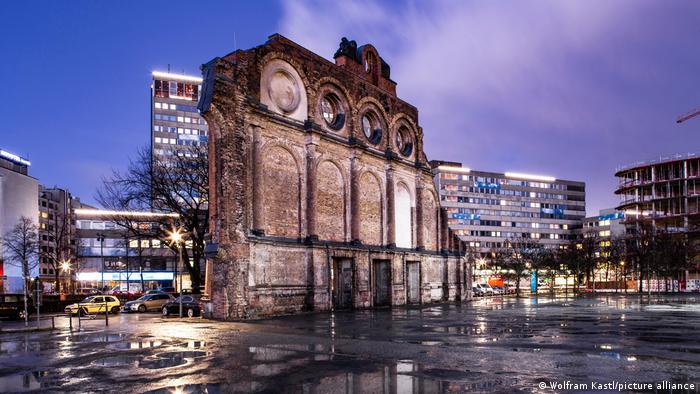The Exile Museum in Berlin is intended to commemorate hundreds of thousands of people, often nameless, who fled Germany from the Nazis. Until the opening – 2026 at the earliest – a workshop invites you to get involved.

The museum designed by Dorte Mandrup extends concavely around the ruined portal
It can sometimes take an agonizingly long time from an idea to its realization. In 2013 photographs by the photographer Stefan Moses were published in the volume “Deutschlands Emigranten” – portraits of people who had to leave Germany under National Socialism. The historian Christoph Stölz, former director of the German Historical Museum, wrote the accompanying texts.
The unexpectedly great response to the volume gave rise to the idea of founding a museum in Berlin that would tell the stories and fates of German exiles. Soon after, Stölzl, who died last January, was the founding director of the Exile Museum Foundation. The plans were quickly fleshed out, also thanks to wealthy donors. Former Federal President Joachim Gauck was won as patron, Nobel Prize winner for literature Herta Müller as patron.
Completion no earlier than 2026
A suitable location was quickly found in the area at Anhalter Bahnhof, which had seemed sad for decades and had been lying fallow. In 2020, the foundation presented the Danish Dorte Mandrup, the winner of the architectural competition for the museum building. But as it is with construction projects that want to be financed: It takes time. At the moment, opening is conceivable from 2026 at the earliest.

Flight and exile: Portraits show refugees from then and now
In order to bridge the time until the finished museum and to illustrate what is to be created, the foundation has opened the “Workshop Exile Museum”. Here, visitors should actively experience the creation of the museum and ideally also help to develop it. In a room entitled “Laboratory” there are tables whose tops correspond to the shapes of the later exhibition rooms. Floor plans can be designed and discarded with colorful adhesive tapes, installations can be planned and redesigned. In the “studio” next door, interviews with refugees from then and now are running.
Floor plans made of adhesive tape
On the opening weekend, around 20 people came to the workshop for the first tour of the day. On the second floor of the old building portraits of exiles hang on two walls facing each other. Willy Brandt, who later fled Germany to Norway in 1933 because of his political resistance against the Nazis, looks at a young woman who recently fled Afghanistan to Germany with her mother – also because she wasn't allowed to go to school there.
In the face of the Ukraine war, the taking in of millions of refugees and ongoing attempts to flee across the Mediterranean, an exile museum has to bridge the gap between then and now. A flip dot hangs from the ceiling, a mechanical scoreboard like those found in train stations or airports. The individual tiles rotate and always give new quotes from people who had to flee their homeland: “The body is now HERE”. It cannot be distinguished whether the statements come from 1933 or from the year 2023.

The “laboratory” of the Exilmuseum workshop
The audience this afternoon is mostly of mature age and doesn't really want to participate in what the workshop is supposed to be about comes. However, the group doesn't want to write anything down, preferring to ask questions and discuss: How is the financing going? Doesn't the museum at the Anhalter Bahnhof conflict with the documentation center Flight, Expulsion, Reconciliation, which opened in June 2021 across the street?
The workshop has to experiment itself
The visitors are interested and well informed, but some things are not yet tangible or concrete enough for them. Soon there will be more employees of the museum foundation than visitors sitting around the interactive table. The foundation will have to experiment to find the right approach to the public – to young people, including the exile society.
The workshop will be open every Thursday between 3 p.m. and 6 p.m. Numerous workshops are being planned – including with young people, on the subject of dance and the “Exile in Film” series of events in cooperation with the Deutsche Kinemathek. In addition, authors discuss “Writing in Exile” at readings.

Since the late 1950s, the former entrance portal of the Anhalter Bahnhof has been living a lonely existence
The Anhalter Bahnhof in the district of Kreuzberg was one of the most important long-distance train stations in Berlin during the German Empire and the Weimar Republic. After the rise of the National Socialists and especially after Adolf Hitler seized power in the spring of 1933, many exiles left the city via the Anhalter Bahnhof. From 1942 the station was used by the Nazis to deport Jews to the Theresienstadt concentration camp.
Historical place of expulsion
After the demolition of the station in 1959, only the ruined portal remained, which was used for the new museum building will be upstream. The property is owned by the district of Friedrichshain-Kreuzberg, which supports the project. It is planned to leave the property to the museum foundation via heritable building rights. The budget committee of the newly elected House of Representatives still has to agree. And finally, of course, the financing still has to be clarified.
Originally, the museum was to be built entirely from private funds, but the construction costs, which were initially estimated at 30 million euros, have now doubled, in particular due to the general energy and raw materials -Cost increases as a result of the Ukraine war. 20 million euros have been collected from private donations, 40 million are missing. The foundation hopes for public participation.